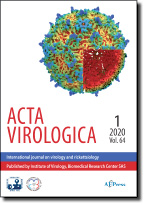Journal info
|
||
Select Journal
Journals
Bratislava Medical Journal Endocrine Regulations General Physiology and Biophysics Neoplasma Acta Virologica Current articles 2023 2022 2021 2020 2019 2018 2017 2016 2015 2014 2013 2012 2011 2010 2009 2008 2007 2006 2005 2004 2003 Studia Psychologica Cardiology Letters Psychológia a patopsych. dieťaťa Kovove Materialy-Metallic Materials Slovenská hudbaWebshop Cart
Your Cart is currently empty.
Info: Your browser does not accept cookies. To put products into your cart and purchase them you need to enable cookies.
Acta Virologica Vol.65, No.2, p.127-140, 2021 |
||
| Title: Anti-biofilm activity of bacteriophages and lysins in chronic rhinosinusitis | ||
| Author: Marzanna Łusiak-Szelachowska, Beata Weber-Dąbrowska, Maciej Żaczek, Andrzej Górski | ||
| Abstract: Chronic rhinosinusitis (CRS) is an otolaryngological disease with a recalcitrant nature, predominantly due to antibiotic resistant bacteria and the biofilm formation. The intracellular residency of Staphylococcus aureus bacteria was observed in CRS. The overall prevalence of CRS is estimated between 5–15% in the human population, and biofilms were formed in sinuses in 40–80% of cases. The bacterial species S. aureus and Pseudomonas aeruginosa are known to form difficult to treat biofilms in CRS. Bacteriophages (phages) or lysins can be alternatives to antibiotics in the biofilm treatment. The application of a P. aeruginosa phage cocktail ex vivo decreased biofilm biomass of bacterial isolates from the sinuses of CRS patients by a median of 70%. Further, animal studies performed on a sheep sinusitis model demonstrated significant reduction in S. aureus and P. aeruginosa biofilm biomass by phage cocktails while maintaining safe prolonged topical application (up to 20 days). Staphylococcal lysin P128 used at a concentration of ≥12.5 µg/ml in vitro against the biofilm of methicillin sensitive S. aureus (MSSA) and methicillin resistant S. aureus (MRSA) isolates from the sinuses of CRS patients demonstrated a significant reduction of the biofilm (up to 95.5%). Staphylococcal lysin CHAP(k) applied in vivo in mice nasal infection caused a significant 2 log reduction of S. aureus suggesting its potential use against bacteria in nasal mucosa. Furthermore, a beneficial effect of phage therapy in the treatment of chronic sinusitis in humans was observed. Here, we summarize the recent, quite scarce data regarding phage application in chronic rhinosinusitis and look further into this phenomenon. |
||
| Keywords: bacteriophages; biofilm; chronic rhinosinusitis; lysins; phage therapy | ||
| Published online: 01-Feb-2021 | ||
| Year: 2021, Volume: 65, Issue: 2 | Page From: 127, Page To: 140 | |
| doi:10.4149/av_2021_203 |
||
|
|
 download file download file |
|

